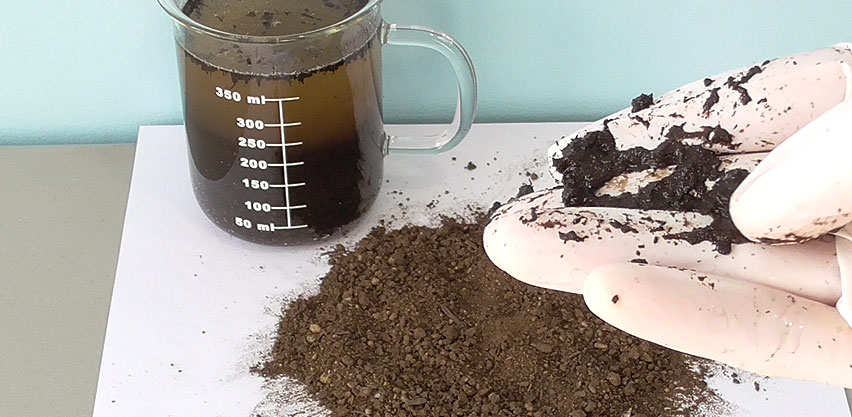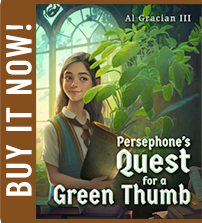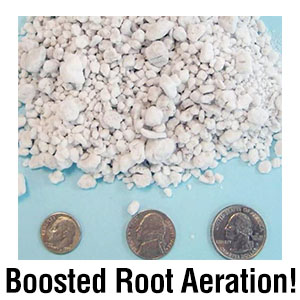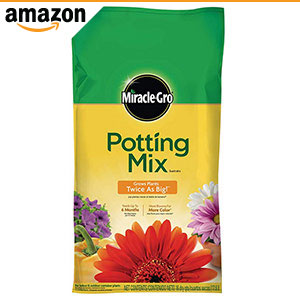Garden Soil
vs Potting Mix:
Structural Differences
Hydroponic growing can achieve some very impressive results. But so can the more conventional approaches of growing in "dirt". In-ground or container plantings use a soil medium that contains at least some organic materials.
I've seen amazing results using fertile soil (for raised beds) and potting mix (for containers). The buffering capacity of a soil or potting mix helps to store excess nutrients. It also reduces the impact of pH changes. In other words, soil is forgiving!
Traditional soil sciences focus around in-ground materials. The building blocks of a native soil are derived from rocks that have been weathered down over a long period of time. As the rocks are broken down, they result in several basic particle sizes. Each particle size directly effects your soil's fertility and its ability to store or drain water.
Basic Top Soil Particles:
SAND - largest particle size, water draining additive. The pH of clean, washed sand is near-neutral (7.0). Its density is very high, adding a lot of weight if used in containers. Only use coarse (builder's) sand (to avoid compaction). It is not very expensive and the added weight could be useful for top-heavy containers that do not need to be moved much. However, sand has poor water retention capacity. As a result, it is not normally used for container gardening. But most importantly, it should never be used in sub-irrigated planters.
SILT - a dust-like sediment derived from rock and mineral particles. Its particle size is smaller than sand but larger than clay. It has unique properties, feeling powdery when dry and slippery when wet. It is highly mobile and is subject to both water and wind erosion. Silty soils tend to be more fertile. However, silts should not be incorporated into container mixes.
CLAY - smallest particle size. Soils with high clay content take longer to absorb water but can retain that water for a longer period. This results in higher fertility than sandy soils because plant nutrients are retained. Clay soils can withstand wind and water erosion better than sandy soils, because the particles are more tightly connected. When used as an additive to sawdust or pine bark, some clays have increased plant production. But clay is not used in container gardening and should never be incorporated into SIPs.

Retail bagged top soil & manure products have a very silty texture, getting mucky when wet.
Top Soil vs Potting Mix:
These basic elements of our top soils are usually available in varying ratios, resulting in unique soil characteristics. Combined with organic matter, you get a soil that can work quite well at providing structure and fertility to our plants. This is particularly true when you account for living soil biology. Earthworms for example serve a role in structurally altering the soil, creating air chambers that enhance aeration.
However, when placed in a container, sand, silt and clay won't perform nearly as well. The containers develop a perched water table causing excess water build up at the bottom. And the soil biology is greatly impaired. Thus, plants grown in containers work best in a "potting mix" rather than traditional garden soil. The physical characteristics of the mix are finely tuned for container growing, ensuring optimal results.
It's a lot more complex than just digging up some dirt and throwing it into a pot! Some gardeners have tried to do just that, only to find that their containers turned into a mucky mess. And of course, their plants suffered as a result, even dying of root rot! That's why you should never buy a bagged top soil or manure product to use for potted plants.
Fortunately, there are plenty of container mix options which can ensure maximum success in your garden.
Video: Best Homemade Seed Starting Potting Mix
Test / Review - Miracle Gro, Espoma, Organic DIY
Stop overpaying for seed starting mixes! Learn how to make a DIY seed starting mix that's better than retail.
Selecting Potting Mix
If you're new to container gardening, Miracle-Gro Potting Mix works fine for beginners. The Moisture Control supposedly helps with moisture irregularities. Some people dislike the Scott's Miracle-Gro brand, particularly since Scotts distributes Roundup (Glyphosate) a nasty herbicide produced by Monsanto (Bayer). If you're determined to avoid any Scotts branded products, there are lots of reputable bagged mixes out there -you just need to look!
One popular alternative would be to go with Pro-Mix. You need to see how the pricing is in your area though. I've found the stuff to be rather overpriced for something that is little more than a bag of peat moss. You may find some other reputable brand sold in your locality. Whatever you buy, I advise pricing the potting mix per quart or cubic foot. See what brand and bag sizes offer the best value. And always pay attention to sales so you don't get ripped off!
You'll need to refresh your mix after the 1st growing season. Once those nutrients have been depleted, the potting mix is rendered impotent ... (nobody wants that). You can read more about that here.
Rather than buying an overpriced potting mix, couldn't you just make a DIY potting mix from scratch??? Sure! Let's look at common components used in growing mediums. This will enable you to make your own specialized mix!


![Pre-Industrial Revolution CLIMATE CONTROL [Gardening T-Shirt Design] Pre-Industrial Revolution CLIMATE CONTROL [Gardening T-Shirt Design]](images/Pre-Industrial-Revolution-CLIMATE-CONTROL-carbon-sequestering_Gardening-Tshirt-Spreadshirt.jpg)
